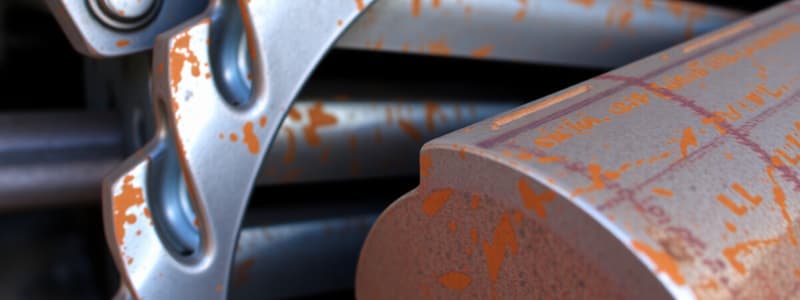Podcast
Questions and Answers
What is the primary difference between carbon steel and alloy steel?
What is the primary difference between carbon steel and alloy steel?
Carbon steel has a higher percentage of carbon, while alloy steel includes additional elements to enhance certain properties.
List two applications of carbon steel.
List two applications of carbon steel.
Carbon steel is used in the manufacture of machine elements and pipes.
How does the addition of manganese affect alloy steel?
How does the addition of manganese affect alloy steel?
Adding manganese increases the impact resistance of alloy steel.
Define low carbon steel and its carbon content.
Define low carbon steel and its carbon content.
What role do elements like tungsten play in alloy steel?
What role do elements like tungsten play in alloy steel?
Why is steel considered one of the most important materials in construction?
Why is steel considered one of the most important materials in construction?
What are the three types of steel categorized by carbon content?
What are the three types of steel categorized by carbon content?
What is the carbon content range typically found in steel?
What is the carbon content range typically found in steel?
What is the main characteristic that differentiates martensitic steel from ferritic and austenitic steel?
What is the main characteristic that differentiates martensitic steel from ferritic and austenitic steel?
How is the strengthening of ferritic and austenitic stainless steels achieved?
How is the strengthening of ferritic and austenitic stainless steels achieved?
Why are martensitic and ferritic stainless steels considered magnetic, whereas austenitic stainless steels are not?
Why are martensitic and ferritic stainless steels considered magnetic, whereas austenitic stainless steels are not?
What role does chromium play in the structure of stainless steel?
What role does chromium play in the structure of stainless steel?
What happens to the ferritic structure of stainless steel when chromium content exceeds 12%?
What happens to the ferritic structure of stainless steel when chromium content exceeds 12%?
How does increasing carbon content affect the phase diagram of stainless steel?
How does increasing carbon content affect the phase diagram of stainless steel?
Why is a higher chromium content beneficial for corrosion resistance in iron?
Why is a higher chromium content beneficial for corrosion resistance in iron?
What is the effect of insufficient chromium content in stainless steel?
What is the effect of insufficient chromium content in stainless steel?
What is the crystal structure of ferrite at room temperature?
What is the crystal structure of ferrite at room temperature?
At what temperature does ferrite transform into austenite?
At what temperature does ferrite transform into austenite?
What is the maximum carbon content of austenite?
What is the maximum carbon content of austenite?
Describe the mechanical properties of cementite (Fe3C).
Describe the mechanical properties of cementite (Fe3C).
What is the significance of the temperature range between 1394 °C and 1538 °C for iron?
What is the significance of the temperature range between 1394 °C and 1538 °C for iron?
What happens to austenite at 1538 °C?
What happens to austenite at 1538 °C?
What is the carbon content range where cementite forms from iron?
What is the carbon content range where cementite forms from iron?
What is a characteristic feature of ferrite compared to austenite?
What is a characteristic feature of ferrite compared to austenite?
What does the term 'ferrous' refer to in metallurgy?
What does the term 'ferrous' refer to in metallurgy?
Why is pure iron not widely used?
Why is pure iron not widely used?
What are the two primary types of metals discussed?
What are the two primary types of metals discussed?
What is the significance of iron's abundance in the Earth's crust?
What is the significance of iron's abundance in the Earth's crust?
How does the addition of carbon improve iron?
How does the addition of carbon improve iron?
What property makes iron useful for engineering applications?
What property makes iron useful for engineering applications?
Describe a notable physical property of iron.
Describe a notable physical property of iron.
Why is iron considered magnetic?
Why is iron considered magnetic?
Why is it important to keep the carbon content low in stainless steel?
Why is it important to keep the carbon content low in stainless steel?
What role does nickel (Ni) play in stainless steel alloys?
What role does nickel (Ni) play in stainless steel alloys?
What happens to the austenite phase at low carbon content in stainless steel?
What happens to the austenite phase at low carbon content in stainless steel?
Name the three types of stainless steel alloys based on their crystal structure.
Name the three types of stainless steel alloys based on their crystal structure.
What distinguishes high Ni content stainless steel alloys from low Ni content ones?
What distinguishes high Ni content stainless steel alloys from low Ni content ones?
How does precipitation hardening strengthen stainless steel?
How does precipitation hardening strengthen stainless steel?
What is the influence of FCC structure on the stability of iron alloys?
What is the influence of FCC structure on the stability of iron alloys?
Explain the effect of chromium content on the protective oxide film in stainless steel.
Explain the effect of chromium content on the protective oxide film in stainless steel.
Flashcards are hidden until you start studying
Study Notes
Steel
- An iron-carbon alloy, with a carbon content typically less than 1.0 wt%
- Used in skyscrapers, buildings, bridges, structures, railroads, and other applications
- Divided into three types based on carbon content:
- Low carbon steel
- Medium carbon steel
- High carbon steel
Carbon Steel
- Has a higher carbon percentage and a small concentration of manganese
- Increases tensile strength but decreases toughness and ductility
- Used in machine elements, engines, vehicles, spare parts, pipes, and other applications
Alloy Steel
- Iron and carbon with the addition of various elements to improve its properties
- Different elements contribute to different properties:
- Manganese increases impact resistance
- Tungsten produces steel resistant to high temperatures
- Used in nuts, bolts, tools, and machine parts
- Other materials used in alloy steel: aluminum, sulfur, copper, chromium, nickel, silicon, and vanadium
Low Carbon Steel
- Contains less than 0.15% carbon
- Used in applications that require ductility, formability, and weldability
- Types:
- Baja anti karat martensitic
- Ferritic anti karat coating
- Austenitic anti karat coating
- Martensitic steel can be heat-treated, while ferritic and austenitic steel cannot.
- Strengthening of ferritic and austenitic stainless steels is done through cold working.
- Martensitic and ferritic stainless steels are magnetic, while austenitic stainless steels are not.
Ferritic Stainless Steel
- Fe-Cr alloy with a basic ferrite structure
- Chromium is a ferrite stabilizer
- Chromium expands the alpha phase region and narrows the gamma phase region
- Limits the FCC and BCC regions
- Cr content above 12% means no Austenite to Ferrite phase transformation
- Has a ferrite structure from room temperature to its melting point
- Martensite transformation is not possible
- Cr content can be up to 30%
- If carbon content is low, Ferrite is stable in all temperature ranges.
- Higher carbon content can lead to an Austenite phase at high temperatures.
Austenite
- FCC crystal structure
- Non-magnetic
Cementite
- Formed when the solubility limit of carbon in iron is exceeded at temperatures below 727 0C
- Hard and brittle
- Can increase the strength of some steels
Iron Metal
- Second most abundant metal on Earth
- Makes up 5% of the Earth's crust
- Exists in the form of iron oxide, Fe2O3 (hematite), Fe3O4 (magnetite)
- Pure iron has poor properties
- Properties:
- Heavy
- High density
- High melting temperature
- Hard
- Oxidizes easily
- Brittle
- Conducts electricity and heat
- Magnetic
- Easy to recycle
Studying That Suits You
Use AI to generate personalized quizzes and flashcards to suit your learning preferences.




